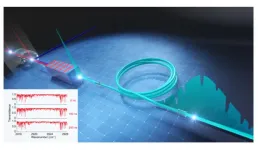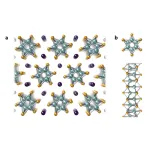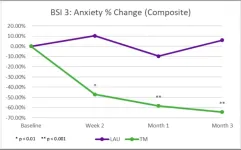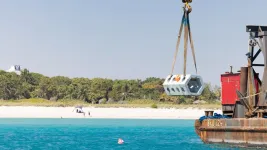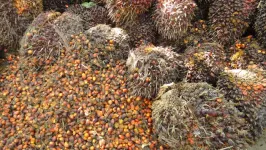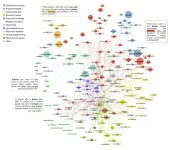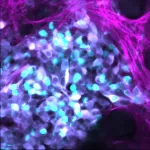Study shows those infected with COVID in the first wave in 2020 were 40% less likely than those who were not to get COVID-19 during the first six months of Omicron activity
Older adults were less likely to be infected during the omicron wave compared to younger adults
2023-03-04
(Press-News.org) **Note: the release below is a special early release from the European Congress of Clinical Microbiology & Infectious Diseases (ECCMID 2023, Copenhagen, 15-18 April). Please credit the conference if you use this story**
Compared to adults who did not have COVID in the first wave (March to September 2020), adults infected with COVID-19 in that first wave were 40% less likely to become infected during the first six months of Omicron activity (December 2021 to May 2022), concludes a new Canadian study to be presented at this year’s European Congress of Clinical Microbiology & Infectious Diseases (ECCMID) in Copenhagen, Denmark (15-18 April). The study was led by Dr Allison McGeer, Sinai Health System, University of Toronto, Canada, and colleagues.
In addition, vaccination, as expected, also offered substantial protection on top of natural immunity. Age was also a factor: older adults (both 65 years and older and aged 50-64 years) were less likely to be infected than younger adults aged 18-49 years in this first six months of the Omicron wave (dominated by BA.1 and BA.2 sublineages).
Patients infected with SARS-CoV-2 between March and September of 2020 were enrolled along with a cohort who were matched on hospitalisation status, age-group, and indication for and timing of SARS-CoV-2 testing who did not have an early infection. Participants completed baseline questionnaires and were followed until May 31, 2022, to identify any respiratory illness, positive COVID test results (PCR or rapid test) and the number and timing of COVID-19 vaccine doses received.
The primary outcome was infection with SARS-CoV-2 between Dec 15, 2021, and May 31,
2022 (the BA.1/BA.2 period). The primary analysis excluded 18 people across both groups who had SARS-COV-2 infections between October 2020 (after the first wave ended) and December 15, 2021(before the Omicron wave started) (8 in the EI group, 10 in the non-EI group), so that the study could make a direct comparison for protection against Omicron between those infected or not infected in the first wave. Multivariable modelling was used to estimate the risk ratio of infection comparing those with and without early SARS-CoV-2 infections, adjusted for age, sex, immunosuppression, household income, calendar time (weeks), number of vaccine doses received, and time from most recent dose.
Data were available for 618 participants with early infection (EI) (282 inpatients and 336 outpatients) and 168 participants without (non-EI). Median age was 56 years for EI and 57 years for non-EI. 325 (53%) EI and 93 (55%) non-EI participants were female. 19 (3%) EI and 8 (5%) non-EI participants were immunocompromised. Among those with complete vaccination information, 539/572 (94%) EI and 136/146 (96%) non-EI participants had received 2 or more doses of a COVID-19 vaccine prior to the onset of the Omicron wave.
During the BA.1/BA.2 period, 84 EI and 36 non-EI participants developed SARS-CoV-2 infections, an incidence of 2.9/100 person-months in the EI cohort versus 4.8/100 person-months in the non-EI cohort. Overall, individuals infected in the first wave early in the pandemic (March to September 2020) had a 40% lower risk of SARS-CoV-2 infection during the Omicron wave than those who were not infected early in the pandemic.
Independent of the presence of early infection, older adults were less likely to be infected in the Omicron wave. Compared with adults aged 18-49 years, those aged 50-64 years were 36% less likely to be infected, and those aged 65 years and older 66% less likely.
Vaccination was also associated with an estimated 24% to 65% reduction in infection during the Omicron wave. The very small number of unvaccinated individuals made estimates of the degree of protection from different numbers of doses and at different times imprecise.
The authors conclude: “Infection with the original first-wave SARS-CoV-2 virus during March to September 2020 was associated with a 40% reduction in the risk of infection during the Omicron BA.1/BA.2 period from December 2021-May 2022. COVID-19 vaccination conferred additional protection, and our study showed younger individuals to be more at risk of infection by Omircon than older age groups.”
Dr Allison McGeer, Sinai Health System, University of Toronto, Canada. T) +1-416-586-3123 E) Allison.McGeer@sinaihealth.ca
Alternative contact in the ECCMID Press Room: Tony Kirby T) + 44(0)7834 385827 E) tony@tonykirby.com
Notes to editors:
This press release is based on abstract 0352 at the European Congress of Clinical Microbiology & Infectious Diseases (ECCMID). All accepted abstracts have been extensively peer reviewed by the congress selection committee. There is no full paper at this stage, but the authors are happy to answer your questions. As this is an early release, no poster is available. The research has not yet been submitted to a medical journal for publication.
END
ELSE PRESS RELEASES FROM THIS DATE:
2023-03-04
Infrared spectroscopy is a non-invasive tool to identify unknown samples and known chemical substances. It is based on how different molecules interact with infrared light. You may have seen this tool at airports, where they screen for illicit drugs. The technique has many applications: liquid biopsy, environmental gas monitoring, contaminant detection, forensic analyses, exoplanet search, etc. But the traditional infrared spectroscopy methods provide low (temporal) resolution data. They are usually only applied for static samples because spectral data acquisition is a slow process. Detecting fast-changing phenomena ...
2023-03-04
Tokyo, Japan – Researchers from Tokyo Metropolitan University have successfully threaded atoms of indium metal in between individual fibers in bundles of transition metal chalcogenide nanofibers. By steeping the bundles in indium gas, rows of atoms were able to make their way in between the fibers to create a unique nanostructure via intercalation. Through simulations and resistivity measurements, individual bundles were shown to have metallic properties, paving the way for application as flexible nanowires in nanocircuitry.
Atomic wires of transition metal chalcogenides (TMCs) ...
2023-03-03
Mason Associate Professor of Infectious Diseases and Microbiology, Ramin M. Hakami has received a total of $35,000 in grants from Intellifoods Labs, LLC to continue examining methods to reduce the time to detect the presence of bacteria in food samples.
Numbers and types of foodborne disease occurrences have increased over time and are a major global public health concern. Hakami and his team seek to reduce the time to identify both live and dead bacteria in food samples using fluorescence detection. The team aims to optimize the detection ...
2023-03-03
Healthcare providers (HCP) at three Miami hospitals during the height of the Covid crisis, who practiced the Transcendental Meditation technique (TM), showed a rapid and highly significant reduction in stress-related burnout symptoms such as somatization, depression, anxiety, sleep disturbances, and emotional exhaustion, as well as significant improvement in mental well-being, compared to a parallel matched lifestyle-as-usual group (LAU), according to a new study published today in PLOS ONE.
A total of 65 healthcare providers at the three Miami hospitals (Baptist, ...
2023-03-03
The first piece of a series of concrete structures was lowered into the water off the coast of Miami Beach on Wednesday morning, a massive crane on the deck of a floating barge hoisting the unit into the air and sinking it to the seabed.
During the next six hours, crewmembers aboard the barge would repeat that process until the structures, some stacked on top of each other, were settled on the seafloor, 14 feet below the surface.
To casual observers onshore, the daylong operation might have seemed routine. But this maritime activity was hardly run-of-the-mill.
In ...
2023-03-03
A scientist from Anglia Ruskin University (ARU) will premiere a new piece of music at the SXSW EDU festival that has been created using data beamed back to Earth from interstellar space.
On Thursday, 9 March, Dr Domenico Vicinanza will be joined on stage in Austin, Texas, by Dr Alyssa Schwartz, Visiting Assistant Professor of Flute and Musicology at Fairmont State University, to perform music shaped by scientific readings collected by NASA’s Voyager 1 spacecraft.
Dr Vicinanza, a Senior Lecturer in ARU’s School of Computing and Information Science, is a leading expert ...
2023-03-03
Oil palm trees are the most productive oil crop and global demand is increasing. However, their productivity is due to conventional management practices including high fertilizer usage and herbicide application, resulting in severe environmental damage. A new study by an international, multidisciplinary research team led by the University of Göttingen, shows that shifting to mechanical weeding and reducing fertilizer usage lead to significant increases in both ecosystem multifunctionality and profit. The scientists compared different environmental measures and economic indicators in mechanical weeding, herbicide application, and combinations of these with high and reduced fertilizer ...
2023-03-03
A team of researchers has developed a machine learning model that draws from the contents of news articles to effectively predict locations that face risks of food insecurity. The model, which could be used to help prioritize the allocation of emergency food assistance across vulnerable regions, marks an improvement over existing measurements.
“Our approach could drastically improve the prediction of food crisis outbreaks up to 12 months ahead of time using both real-time news streams and a predictive model that is simple to interpret,” says Samuel Fraiberger, a visiting researcher at ...
2023-03-03
Cancer cells have an innate randomness in their ability to respond to chemotherapy, which is another tool in their arsenal of resisting treatment, new research led by the Garvan Institute of Medical Research shows.
Understanding why some tumour cells become resistant to chemotherapy is a core challenge in cancer research, as chemotherapy is still a frontline treatment for most cancers.
The new research shows that tumour cells from neuroblastoma – cancer that develops in the body’s ‘fight or flight’ sympathetic nervous system – can move between states of responding, or not, to chemotherapy.
“We showed there is ‘noise’ in the process of cell ...
2023-03-03
As a social media user, you can be eager to share content. You can also try to judge whether it is true or not. But for many people it is difficult to prioritize both these things at once.
That’s the conclusion of a new experiment led by MIT scholars, which finds that even considering whether or not to share news items on social media reduces people’s ability to tell truths from falsehoods.
The study involved asking people to assess whether various news headlines were accurate. But if participants were first asked whether they would share that content, they were 35 percent worse at telling truths from ...
LAST 30 PRESS RELEASES:
[Press-News.org] Study shows those infected with COVID in the first wave in 2020 were 40% less likely than those who were not to get COVID-19 during the first six months of Omicron activity
Older adults were less likely to be infected during the omicron wave compared to younger adults
